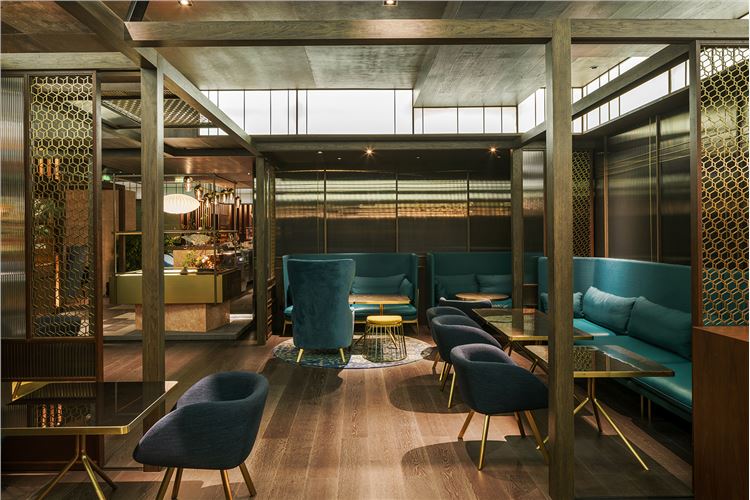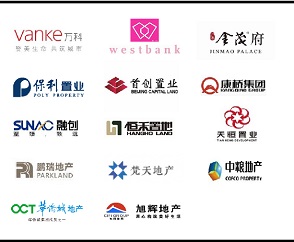Michael McGirr Location: UMI餐厅&酒吧设计
Umi is an upscale bar; lounge and restaurant serving Western influenced Japanese food. Located on the 4th Floor of the much-anticipated new Swire Properties mall in Shanghai, Taikoo Hui, Umi, named after the Japanese word for ocean, opened its doors in early 2018.
Umi 坐落于上海备受瞩目的兴业太古汇商城的四楼,其寓意为海洋,于2018年年初正式开幕营业。Umi的定位为高端酒吧、餐厅,为顾客提供沉浸于西式氛围中的精致日式料理。
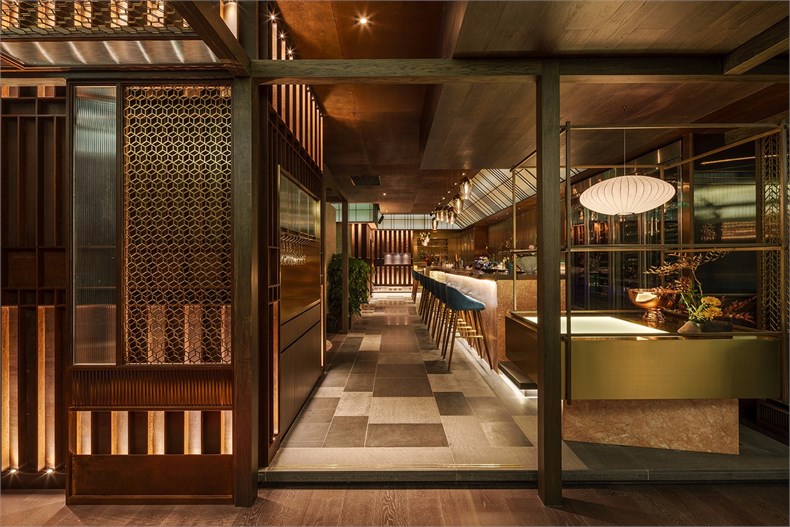
The interior of Umi relates to the unique cuisine of internationally recognized chef Bjoern Alexander, combining traditional Japanese principles of architecture and design with western detailing and finishes. Furniture and lighting details with Western and Japanese origins also create an interesting juxtaposition, fusing two contrasting styles into one cohesive interior space.
Umi 的室内设计与其受国际认证的主厨 Bjoern Alexander 所制作的独特美食有很大的融合关联性,结合传统日式的建筑美学,在设计中巧妙地融日式细节和饰面装饰。同时家具和灯具的选取则体现出西方质感及原生态日式风格的融合,两种风格相映成趣,相得益彰,构成整体品味的融合,极具感染力的室内空间。
A secondary design concept is evident through the material selection, playing with a selection of materials that react to the effects of the sea. From copper that oxidizes with seawater to a teal blue finish to polished steels that have eroded into a rich rusted metal texture, the careful balance of old and new, rough and smooth, help to create a warm and enticing environment.
我们的设计采用了一系列营造大海效果的材料,这将寓于其中的概念设计在材料的选取上被完美地体现出 来,曲尽其妙。从被海水氧化过后的红铜,到在大量生锈金属材质上刷水鸭蓝色涂层,悉心营造的对比感构成了介于“新与旧”“粗糙与平顺”间的完美平衡感。
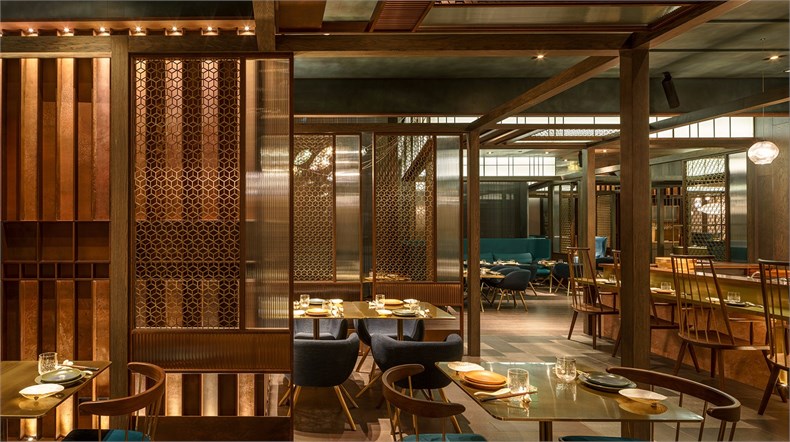
The site, although in a mall, has a unique approach fitting to a Japanese venue. Located on the 4th floor, the only access from the mall is via a private lift from the 3rd. Once exiting the lift, the customer crosses over an expansive terrace with views over the city skyline, before entering the restaurant interior. Spatially this allowed us to create a
distinctly Japanese transition into the lounge: following the Japanese philosophy of Miegakure, to hide and then reveal, one does not expect to land onto the expansive terrace from the small interior greeting lobby.
虽然 Umi 的选址在一座商场内,却有着其独特的通道与日式会所特点相吻合。餐厅位于四楼,却另辟蹊径, 唯一进入四楼的渠道是一座位于三楼的私人电梯。从电梯出来后,进入餐厅前,顾客们会行径穿过带有城市天际景观的宽阔露台。这独树一帜的空间特性使我们的设计可以遵循忽隐忽现的日式哲理,从一个狭小谦卑的迎宾处 们并未意想到被引领整个城市的天台。
The terrace design draws inspiration from Modern Japanese interpretations of a traditional zen garden. A raised platform escorts you across the landscape and into a small, screened entrance lobby, again creating a sense of Miegakure.
露台的设计灵感源于当代日本对于传统禅园的阐释。架空的木栈道将护送顾客穿梭于庭院中心从而进入到一个狭小带有屏风围合的入口 ,这些空间感转换的此起彼落再次传达出忽隐忽现的主旨。
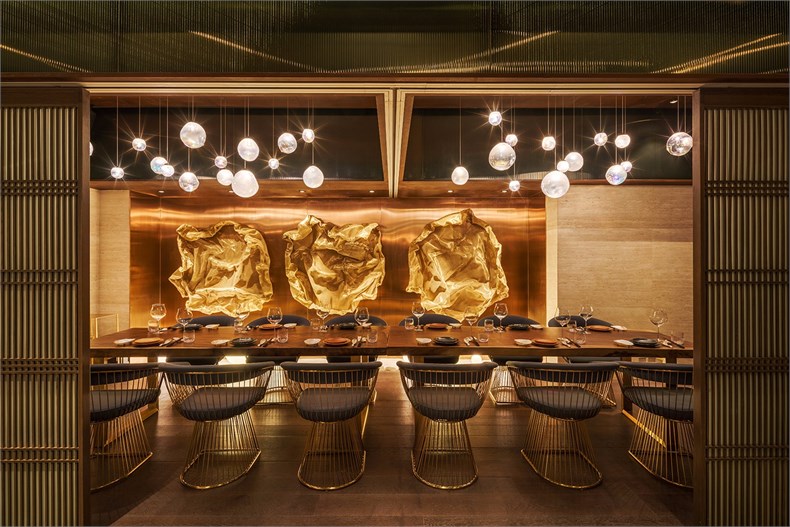
The interior space is divided into two zones demarcated by ‘hat’ like structures: the bar / lounge and the dining space. The bar & lounge is enclosed by backlit shoji screen which subtly light the area. Within this section a 10 metre sake bar is located: with a full display of the finest sakes, whiskeys & spirits, the bar is grounded as the focal point of the space. Behind the bar a wall feature comprised of over 100 pieces of revolving copper/oxidized steel fins rotates asymmetrically, re-creating the subtle shimmer of the sunset reflecting on the sea. This entrance flow creates a sense of wonder; the customer enters via small walkways and through deliberately a tight lobby, enhancing the experience once you enter the space.
整个室内空间被划分为两个区域,以“帽檐”结构形式界定,分为吧台、酒吧及就餐区域。吧台和酒吧区域被后部带有光感折射的屏风围起,微妙地提升了此区域的亮度,同时放置了长达10米的清酒吧台,陈列了一系列 端的清酒,威士忌和白酒。吧台背墙由超过100片旋转的铜板和氧化金属栏栅所组成,再次将类似于反射在海浪上的落 微光轻撒在吧台上,犹如夕阳与大海的照映波光粼粼。所有独具匠心的设计元素 都使得此区域成为视觉焦点。整个探店体验更像是从曲径通幽的小道上漫游至恣意形似的紧凑前厅,但也因此更加强了顾客进入室内后的感官体验。
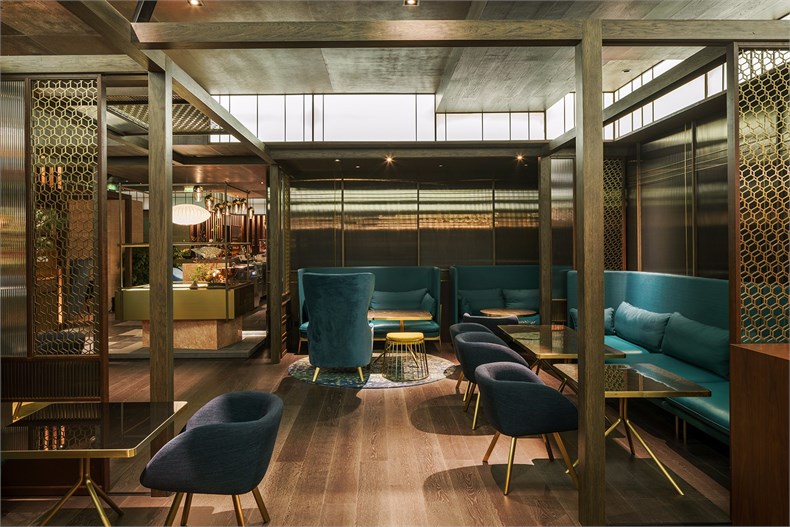
The second roof structure encloses the dining space towards the rear of the restaurant. This structure, clad on the underside with blue oxidized steel, represents the sense of being submerged within the deep ocean. Clusters of accent lighting with iridescent linings, like shoals of fish, continue the ‘umi’ atmosphere within the space. To enhance the intimacy of the space and provide flexibility, sliding screens inspired by the traditional Japanese home are used to redefine the original configuration. The design detail of these screens highlights the conceptual approach of Umi: although following the template of a shoji screen, the paper has been replaced with fluted glass; the wooden finned structural details replaced with copper fins and Japanese wooden screen patterns swapped out for laser cut steel screens. The play between the two design languages creates a unique environment where Asian tradition meets Western influences
第二层天花结构的底部覆盖了经氧化呈现蔚蓝的氧化金属铁,在餐厅的更深一层用餐区被亲密的环抱,传达出仿佛置身于深海的神秘之感。装饰上簇拥的塑形灯具,带着斑斓的衬里,就像大海里成群的鱼,演着“Umi”海洋进行曲,翩翩起舞。同时为了增强空间的私密感和灵活性,安装了在日式传统家装基础改良后的可移动屏风。设计精髓秉承传统日式屏风的元素,而在细节部分,传统的宣纸被波纹玻璃取而代之,细部结构则被红铜栏栅取代,日式木质屏风的图腾由激光切割后的金属屏风所替代。介于两种设计体系之间的大胆革新,将亚洲传统设计融合日式元素,赋予了整个空间独特的张力 。
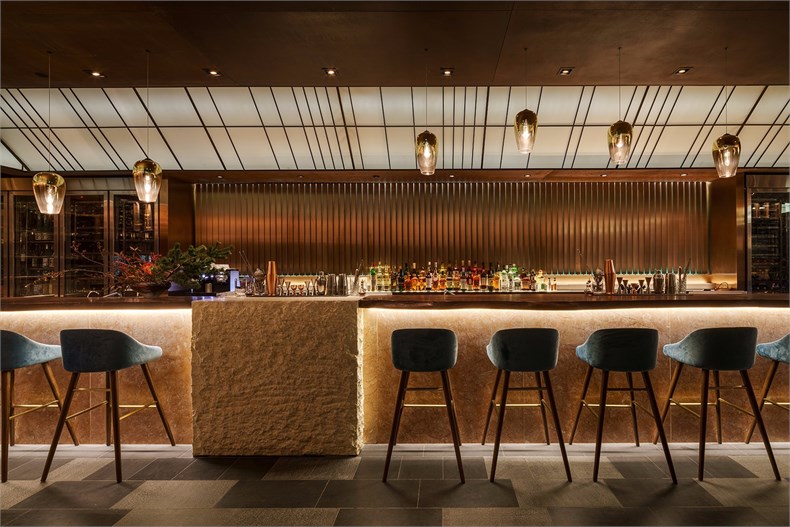
To complete the space the semi private dining rooms open up from their traditional shoji screen boundaries to proudly expose a wall feature themed on the prime product of the restaurant: the oyster. Three hand-made oyster shells structures, molded from Brass mesh, hang in front of a copper backdrop. Floating in front of these shells, the oyster’s pearls form a soft light feature. This three-dimensional installation, playing with light, reflection and texture, is inspired by the heart of Umi.
为了诠释半开放包房的私密性并呼应前场屏风设计的里应外合,在空间中引用铜质金属制作的生蚝外壳结构,将它们悬挂于红铜背景墙前,用柔和的光线营造出生蚝内部的珍珠光泽,恰当展现出与餐厅高端生蚝菜肴相匹配的主题墙。同时这三处金属网的安装,在光影流动间,使室内灯光,投影与材质本身相映成辉,这一独一无二的设计理念迸发于Umi,海洋主旨的灵魂。
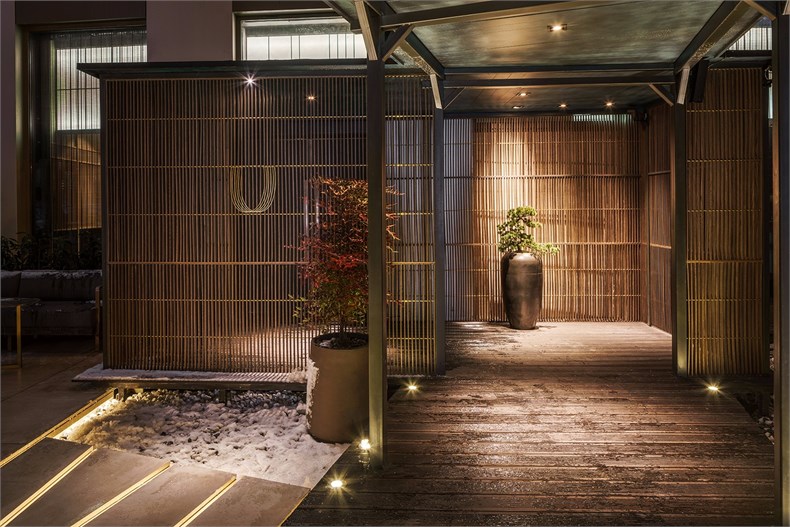

Project: UMI restaurant & bar Date: 2018. 02. 21
Project credentials [UMI]
Project name| UMI
Year of completion | 2018 January
Project location | L321&L401 288 Shimen Yi Road, Jing An, Shanghai Interior design company | red design
Lead designer | Michael McGirr Location | Shanghai, China Area| 400 SQM
Photographer | Seth Powers
Edit by Designwire
